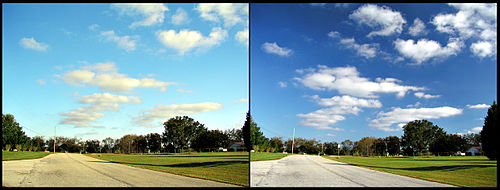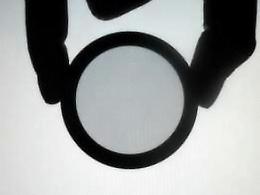How Do Polarized Filters Work

Round polarizer/linear analyzer[ane] filtering unpolarized light and so circularly polarizing the issue.
A polarizing filter or polarising filter (see spelling differences) is often placed in forepart of the camera lens in photography in order to darken skies, manage reflections, or suppress glare from the surface of lakes or the sea. Since reflections (and sky-light) tend to be at to the lowest degree partially linearly-polarized, a linear polarizer tin be used to modify the residue of the light in the photo. The rotational orientation of the filter is adjusted for the preferred artistic effect. For mod cameras, a circular polarizer (CPL) is typically used; this comprises firstly a linear polarizer which performs the artistic function just described, followed by a quarter-wave plate which further transforms the now-linearly polarized light into circularly-polarized light before entering the camera. This boosted footstep avoids problems with autofocus and light-metering sensors within some cameras, which otherwise may non function reliably with a unproblematic linear polarizer.
Use [edit]

Filtered on right, ⇢. A polarizer filters out the polarized component of light from the sky in a colour photograph, increasing contrast with the clouds (right).

Filtered on correct, ⇢. Polarizer aligned to allow the lite reflected by the h2o (left), rotated by ninety° to block it (correct).

Filtered on right, ⇢. Polarizers are often used to improve the appearance of vegetation.

Filtered on correct, ⇢. Outcome of polarizer on light reflected from a water surface. The polarizing filter is used on the right.


Filtered on right, ⇢. A glass squid photographed without (left) and with a polarizing filter (right)

Filtered at lesser, ⬇. Toughened glass of motorcar rear window. Variations in glass stress are conspicuously seen when photographed through a polarizing filter (bottom picture).

Blithe polarizer in front of a computer apartment screen monitor. LCD monitors emit polarized lite, typically at 45° to the vertical, so when the polarizer axis is perpendicular to the polarization of the low-cal from the screen, no lite passes through (the polarizer appears blackness). When parallel to the screen polarization, the polarizer allows the lite to pass and the white of the screen is seen.
Video of the effects of a polarizer.
| 0 degrees rotation | xxx degrees rotation |
|---|---|
 |  |
| 60 degrees rotation | xc degrees rotation |
 |  |
Light reflected from a not-metallic surface becomes polarized; this effect is maximum at Brewster's angle, most 56° from the vertical for common drinking glass. A polarizer rotated to pass only light polarized in the direction perpendicular to the reflected light will absorb much of it. This absorption allows glare reflected from, for example, a torso of water or a route to be reduced. Reflections from shiny surfaces (due east.m. vegetation, sweaty peel, water surfaces, glass) are also reduced. This allows the natural color and detail of what is beneath to come up through. Reflections from a window into a dark interior can be much reduced, allowing it to exist seen through. (The same effects are available for vision past using polarizing sunglasses.)
Some of the light coming from the sky is polarized (bees utilise this phenomenon for navigation[2]). The electrons in the air molecules cause a scattering of sunlight in all directions. This explains why the sky is non night during the twenty-four hour period. Simply when looked at from the sides, the light emitted from a specific electron is totally polarized.[three] Hence, a movie taken in a management at xc degrees from the sun can take advantage of this polarization. Actually, the effect is visible in a band of 15° to 30° measured from the optimal direction.
Apply of a polarizing filter, in the correct direction, will filter out the polarized component of skylight, darkening the sky; the landscape beneath it, and clouds, will be less affected, giving a photograph with a darker and more dramatic sky, and emphasizing the clouds.[4] Perpendicularly incident lite waves tend to reduce clarity and saturation of sure colors, which increases haziness. The polarizing lens effectively absorbs these lite waves, rendering outdoor scenes crisper with deeper color tones in discipline matter such as blue skies, bodies of water and leaf.[5]
Much light is differentiated by polarization, east.k. lite passing through crystals like sunstones (calcite) or water droplets producing rainbows. The polarization of the rainbow is acquired by the internal reflection. The rays strike the dorsum surface of the drop close to the Brewster angle.[half dozen]
Polarizing filters can be rotated to maximize or minimize admission of polarized light. They are mounted in a rotating neckband for this purpose; one need not spiral or unscrew the filter to adjust the effect. Rotating the polarizing filter will make rainbows, reflections, and other polarized light stand up out or nigh disappear depending on how much of the light is polarized and the bending of polarization.
The benefits of polarizing filters are the same in digital or picture photography. While software postal service-processing can simulate many other types of filter, a photograph does not record the light polarization, then the furnishings of controlling polarization at the time of exposure cannot exist replicated in software.
Types [edit]
There are two types of polarizing filters readily available, linear and circular, which have exactly the same effect photographically. But the metering and machine-focus sensors in certain cameras, including nearly all car-focus single-lens reflex cameras (SLRs), will not work properly with linear polarizers because the axle splitters used to split up off the light for focusing and metering are polarization-dependent. Linearly-polarized lite may also defeat the activeness of the anti-aliasing filter (low-laissez passer filter) on the imaging sensor.
Circular polarizing photographic filters consist of a linear polarizer on the front end, with a quarter-moving ridge plate on the back. The quarter-wave plate converts the selected polarization to circularly polarized lite inside the camera. This works with all types of cameras, because mirrors and beam-splitters split circularly polarized light the same way they carve up unpolarized calorie-free.[seven]
Linear polarizing filters tin can be easily distinguished from circular polarizers. In linear polarizing filters, the polarizing effect works (rotate to see differences) regardless of which side of the filter the scene is viewed from. In "circular" polarizing filters, the polarizing effect works when the scene is viewed from the male threaded (back) side of the filter, merely does not work when looking through information technology backwards.
Other effects [edit]
Polarizing filters reduce the light passed through to the motion picture or sensor by about one to iii stops (ii–8×) depending on how much of the light is polarized at the filter angle selected. Auto-exposure cameras will adjust for this by widening the discontinuity, lengthening the time the shutter is open, and/or increasing the ASA/ISO speed of the camera. Polarizing filters can exist used deliberately to reduce available light and allow employ of wider apertures to shorten depth of field for certain focus effects.
Some companies make adjustable neutral density filters by having two linear polarizing layers. When they are at xc° to each other, they allow almost zero light in, albeit more as the angle decreases.
Run across likewise [edit]
- Polarized 3D glasses
References [edit]
- ^ Handbook of Optics Second edition vol2, Ch22.19, Bass G An all-encompassing quote has been copied and pasted
- ^ Wehner, R. (July 1976). "Polarized-calorie-free navigation by insects". Scientific American. Vol. 235, no. 1. pp. 106–fifteen. ISSN 0036-8733.
- ^ Halliday, David, Resnick, Robert (1966). Physics, p. 1167. John Wiley, New-York.
- ^ "DSLR Tips Workshop: How to use polarizing filters to reduce haze and deepen blue sky".
- ^ Emma David for FreePhotoCourse.com. "How to Photography: Nighttime Blue Sky". world wide web.FreePhotoCourse.com. Retrieved June 6, 2011.
- ^ "Rainbow, halo and glory".
- ^ Norman Goldberg (1992). Camera Engineering science: The Dark Side of the Lens. Academic Press. pp. 141–147. ISBN978-0-12-287570-0.
External links [edit]
- Polarizer another must-have filter
How Do Polarized Filters Work,
Source: https://en.wikipedia.org/wiki/Polarizing_filter_(photography)
Posted by: confernotilen.blogspot.com


0 Response to "How Do Polarized Filters Work"
Post a Comment